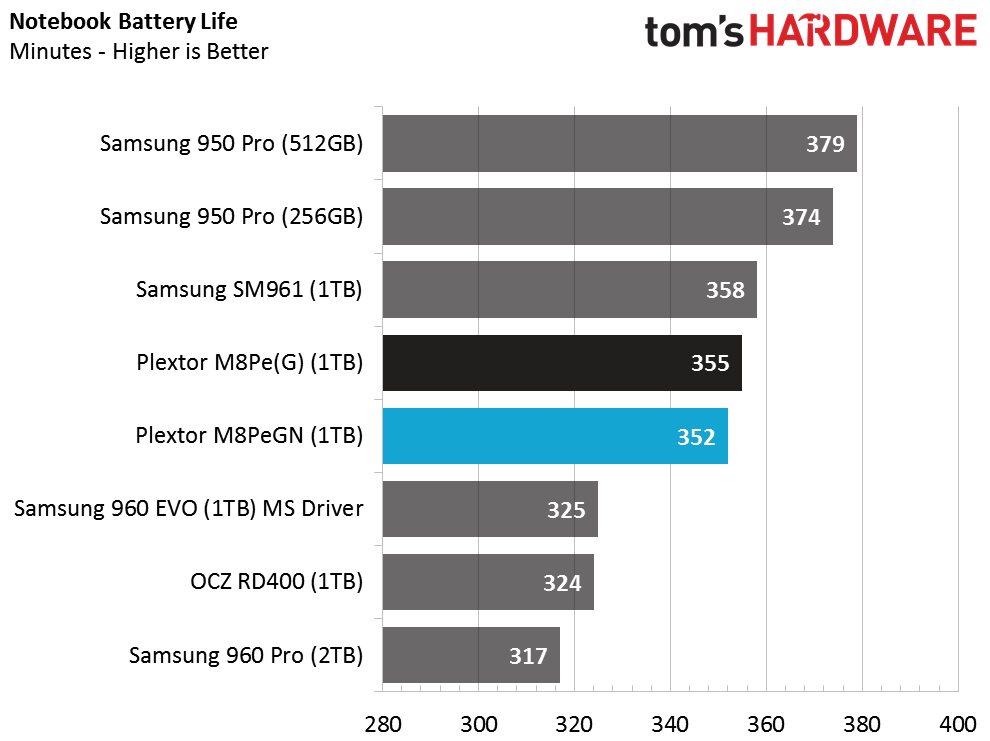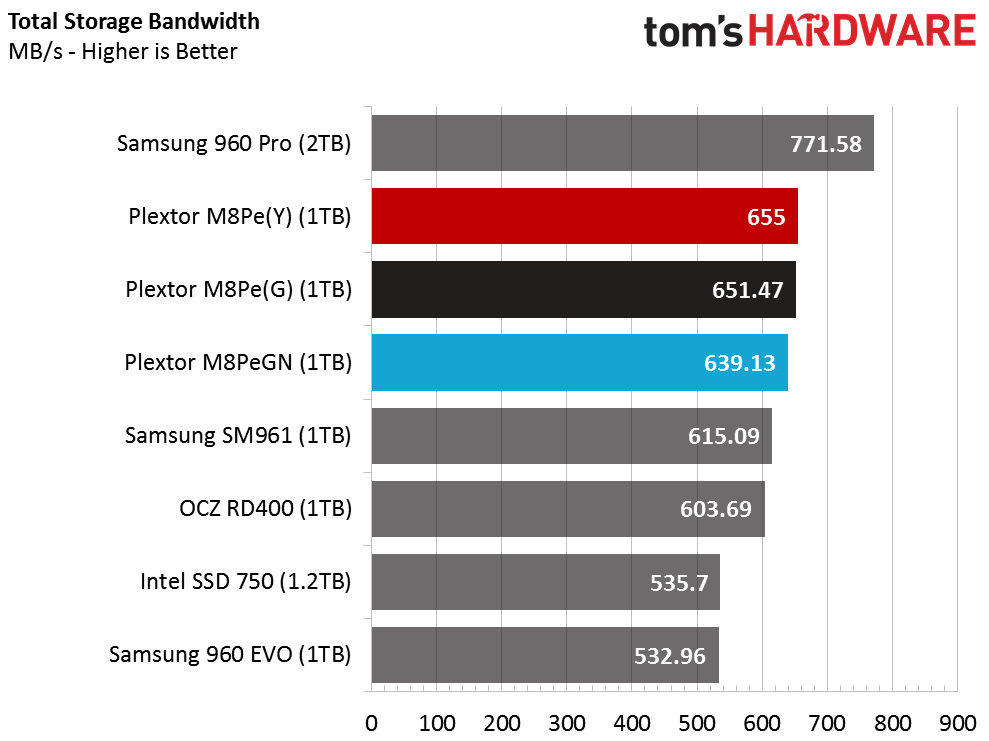Plextor M8Pe Series SSD Review
Why you can trust Tom's Hardware
1TB Benchmark Results
Comparison Products
We have all three Plextor M8Pe 1TB SSDs in this review. A stellar class of high-performance NVMe SSDs accompanies them in our test pool.
At this time, the Samsung 960 Pro is the king of the hill. We only have this drive in the 2TB capacity, but hope to test the 1TB and 512GB as Samsung brings them to market. The OEM SM961 and the 960 EVO are also from the South Korean camp. We will pay particular attention to how well the M8Pe 1TB compares to the 960 EVO 1TB because both share similar pricing. The Intel SSD 750 1.2TB and OCZ RD400 1TB premium SSDs are also in the charts.
The current NAND shortage has made it difficult to secure high die count NAND packages, so there is a shortage of high-capacity NVMe SSDs. The Intel 600p, which just started shipping, is the only entry-level 1TB NVMe SSD in our test pool.
Sequential Read Performance
To read about our storage tests in-depth, please check out How We Test HDDs And SSDs. We cover four-corner testing on page six of our How We Test guide.


In our first test, we observe the effects of thermal throttling on the Plextor M8PeGN (no heatsink). The two M8Pe models with heatsinks don't throttle during the long test. The Plextor SSDs’ sequential write performance at queue depth 1 starts in the lower performance tier, which essentially consists of everything not made by Samsung.
The Plextor M8Pe SSDs scale well as additional workload intensity comes in via increased queue depth. By QD4, the M8Pe SSDs have reached their peak performance around 2,300 MB/s.
Sequential Write Performance


The M8PeGN without a heatsink exhibits some signs of thermal throttling again due to the extended test cycle. All of the synthetic tests execute from a scripted batch file. There are very few pause commands during the suite, and we press the drives for over an hour. The test idles the device under test (DUT) at various stages to limit steady-state conditions and throttling.
Get Tom's Hardware's best news and in-depth reviews, straight to your inbox.
The OCZ RD400 also shows signs of thermal throttling during extended sequential write workloads. The two Plextor M8Pe products with a heatsink fare much better. I didn't expect the M.2 heatsink to work as well as it does. The combination of the dense thermal pad and the sliver of anodized aluminum work in conjunction to absorb the heat from the controller. We are not surprised to see the add-in card performing so well in its fight against throttling. It uses one of the largest heat sinks of any SSD to ship in the retail space; it’s even larger than the aftermarket add-in cards.
Performance wise, the M8Pe SSDs trail most of the other 1TB NVMe SSDs on the market during the sequential write workload with 128KB blocks.
Random Read Performance



The Plextor M8Pe SSDs fall right into the middle of the pack during the random 4KB read test at QD1. The 960 EVO is the M8Pe's biggest competitor based on price, and it sits at the top of this chart due to Samsung's Intelligent TurboWrite feature. The 960 EVO's SLC buffer only serves as a solution for burst data, but most consumer workloads are bursty in nature.
Random Write Performance



The random write test proved to be especially difficult for the M8Pe. All three drives trailed the rest of the NVMe pack in this test from low to high queue depths.
80% Mixed Sequential Workload
We describe our mixed workload testing in detail here and describe our steady state tests here.
Mixing sequential data reads and writes doesn't faze the Plextor M8Pe NVMe SSDs. The performance beyond QD4 is fairly consistent. Plextor's drives deliver nearly identical performance to Samsung's SM961, which comes packing the Polaris controller and 48-layer MLC V-NAND.
80% Mixed Random Workload
Only two 1TB NVMe SSDs stand out in the random mixed data test under light load; the OCZ RD400 and the Samsung 960 Pro. The other drives all cluster together at low queue depths.
Sequential Steady-State



Many of Plextor’s SSDs use TrueSpeed technology, which is the company's branded name for a suite of garbage collection, disk cleanup, and other background activities. Every company has many options on how to tackle these tasks. Some strategies work better than others, and one way may work really well in one scenario, but not so well in another.
Plextor's TrueSpeed algorithm doesn't work well in steady-state conditions. During the 100% write phase, the M8Pe SSDs perform like TLC-based products, like the Samsung 960 EVO. Under heavy read workloads, such as 70- and 80-percent mixtures, the large heatsink on the add-in card really helps to boost performance. In both workloads, we see the add-in card at the upper end of the chart, but without heavy cooling, the M8Pe falls to the bottom of the chart. Sequential workloads tend to tease out high power consumption values, which increases heat output, so the depressed values for the Plextor SSDs with a less robust cooling solution aren't entirely unexpected.
Random Steady-State


The two M8Pe 1TB models with a heatsink run the length of the random 4KB steady-state chart in lockstep. We were surprised to see the 960 EVO with TLC flash delivering slightly higher average performance, though. Most of the drives on the chart deliver consistent performance. The M8Pe models sporadically leap up the IOPS band as the controller reclaims some space and then cleans the cells for a quick burst of increased performance.
PCMark 8 Real-World Software Performance
For details on our real-world software performance testing, please click here.










We used to say that programming (the firmware) was the key to excellent performance. That advantage began to wane when Samsung developed superior NAND technology and then kept the flash for its own branded products. For several generations, Plextor developed strong firmware and had many products that fought for the top performance crown. During the same time, Marvell also shipped controllers that were more competitive. Both companies went through a string of under-performing products, but now they are both on the rise again.
Application Storage Bandwidth
We can't decouple Plextor's firmware from Marvell's new Eldora controller. Plextor is the first SSD manufacturer to bring this controller to market in a retail product. The chart makes it clear that Plextor is back on track. We can also say that the Marvell Eldora controller doesn't stand out as anything special, and neither is the off-the-shelf Toshiba 15nm Toggle MLC NAND. With the puzzle pieces assembled, I'm leaning toward the M8Pe performance coming from the Plextor-optimized firmware.
There are some downsides to over-optimizing for consumer desktop use, though.
PCMark 8 Advanced Workload Performance
To learn how we test advanced workload performance, please click here.



Plextor designed the M8Pe series for gamers, which is a very specialized market. Until recently, consumer NVMe SSDs were workstation-focused and trickled down quickly into enthusiast and power user categories. Gamers are generally considered the next step down the user hierarchy. The M8Pe series is really the first consumer NVMe SSD that targets and optimizes for people that spend too much time playing video games.
We see the downside of that tuning in this series of charts. The background activity delays flash cleanup operations until the SSD needs additional free blocks. Samsung products usually have the most aggressive flash cleanup algorithms. Plextor is at the other end of the scale, and every other company falls in the middle. The M8Pe will take longer to recover after heavy workstation-like workloads.
Under lighter workload conditions, like gaming, you don't want the background activity kicking in unnecessarily. When the drive performs those operations, it adds latency if a data request comes in.
Total Service Time



The delayed cleanup operations make the M8Pe appear to have poor performance during this test. The test uses a heavy workload and then allows a set amount of time for recovery. Since the M8Pe pushes the TRIM command back until a longer idle, or discards it altogether, the Plextor drives appear in these charts with dirty flash.
Disk Busy Time
When most of the flash is dirty, the write operations take longer. The drive must perform a read, modify, and write operation to manipulate the existing data and add new data to the flash media.
Notebook Battery Life


The Plextor M8Pe(Y) add-in card will not run in a notebook. If you remove the SSD from the adapter, you have an M8PeGN. Because of that, only two Plextor M8Pe drives appear in the notebook performance charts. The M.2 2280 drive with a heatsink fit perfectly in our Lenovo Y700-17; they almost look like they were made for each other. Seriously, if either company patented or trademarked the red Y design, then the other company would need to defend an infringement lawsuit.
The Plextor model with the heatsink delivers slightly longer notebook battery life and enjoys a slight bump in performance. Both Plextor M8Pe SSDs reach the top of our performance chart. This round of test occurs with the system using reduced PCIe, CPU, and system memory bus speeds, so the Plextor results are impressive. The amount of time you can run the Lenovo Y700-17 on battery with the M8Pe is average for NVMe products.
Current page: 1TB Benchmark Results
Prev Page Specifications & Features Next Page NEW: 512GB Benchmark Results
Chris Ramseyer was a senior contributing editor for Tom's Hardware. He tested and reviewed consumer storage.






